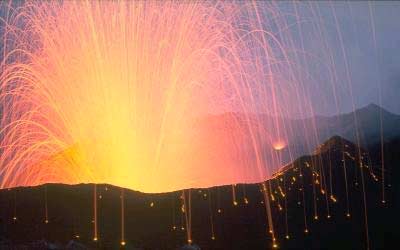Volcanoes May Be Original Womb of Life

Fifty years ago, a chemist named Stanley Miller conducted a famous experiment to investigate how life could have started on Earth.
Recently, scientists re-analyzed his results using modern technology and found a new implication: The original sparks for life on our planet could have come from volcanic eruptions.
The 1950s experiment was designed to test how the ingredients necessary for life could arise.
Miller and his University of Chicago mentor Harold Urey used a system of closed flasks containing water and a gas of simple molecules thought to be common in Earth's early atmosphere. They zapped the gas with an electric spark (representing lightning on ancient Earth), and found that after a couple of weeks the water turned brown. It turned out that amino acids, the complex molecules that make up proteins, had formed from the simple materials in the flasks.
The finding was lauded as proof that the fundamental building blocks of life could be derived from natural processes on our planet.
Recently, Scripps Institution of Oceanography researcher Jeffrey Bada, who was Miller's graduate student when the experiment was first performed, stumbled upon vials containing residues from the tests. In a slight variation on the famous experiment, in some of these trials, steam had been injected into the gas to simulate conditions in the cloud of an erupting volcano. These results had never been made public.
In the newly recovered samples, Bada and his team found 22 amino acids, 10 of which had never been found in any other experiment like this.
Sign up for the Live Science daily newsletter now
Get the world’s most fascinating discoveries delivered straight to your inbox.
"The apparatus Stanley Miller paid the least attention to gave the most exciting results," said team member Adam Johnson, a graduate student at Indiana University. "We suspect part of the reason for this was that he did not have the analytical tools we have today, so he would have missed a lot."
And, after re-analyzing the samples from the original trials that had been published in 1953, the team also found that those flasks contained far more organic molecules than Stanley Miller realized.
"We believed there was more to be learned from Miller's original experiment," Bada said. "We found that in comparison to his design everyone is familiar with from textbooks, the volcanic apparatus produces a wider variety of compounds."
The researchers published the results of their new analysis in the Oct. 16 issue of the journal Science.
Over the past 50 years, scientists have changed their thinking about what elements were present in the atmosphere of early Earth. Miller used methane, hydrogen and ammonia in his experiments, though now researchers think Earth's ancient atmosphere was mostly carbon dioxide, carbon monoxide and nitrogen.
"At first glance, if Earth's early atmosphere had little of the molecules used in Miller's classic experiment, it becomes difficult to see how life could begin using a similar process," said team member Daniel Glavin of NASA's Goddard Space Flight Center in Greenbelt, Md. "However, in addition to water and carbon dioxide, volcanic eruptions also release hydrogen and methane gases. Volcanic clouds are also filled with lightning, since collisions between volcanic ash and ice particles generate electric charge. Since the young Earth was still hot from its formation, volcanoes were probably quite common then."
- 101 Amazing Earth Facts
- Top 10 Questions About Earth
- Greatest Mysteries: How Did Life Arise on Earth?










